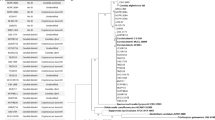Abstract
Infections by yeast strains of the genus Candida are among the most prevalent fungal infections of humans. These yeasts are common residents of the oral mucosa and other body surfaces. Since most yeast infections are due to endogenous strains and that species of Candida differ in virulence properties and in intrinsic susceptibilities to antifungal drugs, understanding the human commensal yeast flora can help designing effective treatment and prevention strategies against yeast infections. Here, we report the patterns of yeast species distributions in the oral cavities of 1,799 people from Hainan Island in southern China. Based on sequence information at the fungal barcode locus ITS regions, 368 of the 415 obtained oral yeast strains were identified as belonging to 26 yeast species, while the remaining 47 strains all showed significant sequence divergence to the currently described species. The four most common yeast species were C. albicans (42 %), C. tropicalis (20 %), C. glabrata (5.5 %), and C. parapsilosis (4.1 %) and 10 of the 26 yeast species were represented by only one strain each. Our analyses identified that the gender of hosts and ethnical background showed no contribution to oral yeast species distributions. However, the health status, place of birth, current residency, and the age of hosts all showed significant contributions to the distributions of the four dominant yeast species. We compared our results with those reported previously and discussed the potential mechanisms for the observed differences in oral yeast species distributions.


Similar content being viewed by others
References
Lederberg J, Shope RE, Oaks SC. Emerging infections. Washington, DC: National Academy Press; 1992.
Odds FC. Candida and candidosis. London: Bailliere Tindall; 1988.
Mitchell TG. Population genetics of pathogenic fungi in humans and animals. In: Xu J, editor. Microbial population genetics. UK: Horizon Bioscience; 2010. p. 139–58.
Krcmey V, Barnes AJ. Non-Candida albicans spp. causing fungaemia: pathogenicity and antifungal resistance. J Hosp Infect. 2002;50:243–60.
Oliver BG, Silver PM, White TC. Evolution of drug resistance in pathogenic fungi. In: Xu J, editor. Evolutionary genetics of fungi. UK: Horizon Bioscience; 2005. p. 253–87.
Peng M, He J, Liu H, Zhang Y. Tracing the legacy of the early Hainan Islanders—a perspective from mitochondrial DNA. BMC Evol Biol. 2011;11:46.
Xu J, Mitchell TG. Geographical differences in human oral yeast flora. Clin Infect Dis. 2003;36:221–4.
Kam AP, Xu J. Diversity of commensal yeasts within and among healthy hosts. Diagn Microbiol Infect Dis. 2002;43:19–28.
Wang H, Wang Y, Chen J, Zhan Z, Li Y, Xu J. Oral yeast flora and their ITS sequence diversity among a large cohort of medical students in Hainan, China. Mycopathologia. 2007;164:65–72.
Schoch CL. Fungal barcode consortium. Nuclear ribosomal internal transcribed spacer (ITS) region as a universal DNA barcode marker for fungi. Proc Natl Acad Sci USA. 2012;109:6241–6.
Sokal RR, Rohlf FJ. Biometry: the principles and practices of statistics in biological research. 2nd ed. NY: Freeman and Company; 1981.
Feng X, Ling B, Yang G, Yu X, Ren D, Yao Z. Prevalence and distribution profiles of Candida parapsilosis, Candida orthopsilosis and Candida metapsilosis responsible for superficial candidiasis in a Chinese University Hospital. Mycopathologia. 2012;173:229–34.
Sedgley CM, Samaranayake LP, Chan JC, Wei SH. A 4-year longitudinal study of the oral prevalence of enteric gram-negative rods and yeasts in Chinese children. Oral Microbiol Immunol. 1997;12:183–8.
Kleinegger CL, Lockhart SR, Vargas K, Soll DR. Frequency, intensity, species, and strains of oral Candida vary as a function of host age. J Clin Microbiol. 1996;34:2246–54.
Xu J, Boyd CM, Livingston E, Meyer W, Madden JF, Mitchell TG. Species and genotypic diversities and similarities of pathogenic yeasts colonizing women. J Clin Microbiol. 1999;37:3835–43.
Ge YP, He GX, Lin T, Lu GX, Shen YN, Liu WD. First isolation of Candida dubliniensis from oral cavities of dermatological patients in Nanjing, China. Mycopathologia. 2011;172(6):465–71.
Le Gac M, Giraud T. Existence of a pattern of reproductive character displacement in Homobasidiomycota but not in Ascomycota. J Evol Biol. 2008;21:761–72.
Qi QG, Hu T, Zhou XD. Frequency, species and molecular characterization of oral Candida in hosts of different age in China. J Oral Pathol Med. 2005;34:352–6.
Pfaller MA, Messer SA, Boyken L, Tendokar S, Hollis RJ, Diekema DJ. Variation in susceptibility of bloodstream isolates of Candida glabrata to fluconazole according to patient age and geographic location. J Clin Microbiol. 2003;41:2176–9.
Tey R, Han S, Yan Z, Li X, Lazzazera K, Sun S, Xu J. Genotypic and phenotypic diversities of human pathogenic yeasts. Research advances in microbiology. Global research. Network. 2003;3:67–85.
Zaremba ML, Daniluk T, Rozkiewicz D, Cylwik-Rokicka D, Kierklo A, Tokajuk G, Dabrowska E, Pawińska M, Klimiuk A, Stokowska W, Abdelrazek S. Incidence rate of Candida species in the oral cavity of middle-aged and elderly subjects. Adv Med Sci. 2006;51(Suppl 1):233–6.
Grimoud AM, Marty N, Bocquet H, Andrieu S, Lodter JP, Chabanon G. Colonization of the oral cavity by candida species: risk factors in long-term geriatric care. J Oral Sci. 2003;45:51–5.
Acknowledgments
We thank the following people for their contributions to our samples: Leilei ZHANG, Jinlong CHEN, and Ying WANG. This study was financially supported by the National Science Foundation of China (grant numbers 30760001 and 31260225) and the Hainan Provincial Key Science Project (Grant numbers 090214 and 801010).
Author information
Authors and Affiliations
Corresponding authors
Rights and permissions
About this article
Cite this article
Wang, H., Xu, J., Guo, H. et al. Patterns of Human Oral Yeast Species Distribution on Hainan Island in China. Mycopathologia 176, 359–368 (2013). https://doi.org/10.1007/s11046-013-9703-7
Received:
Accepted:
Published:
Issue Date:
DOI: https://doi.org/10.1007/s11046-013-9703-7




